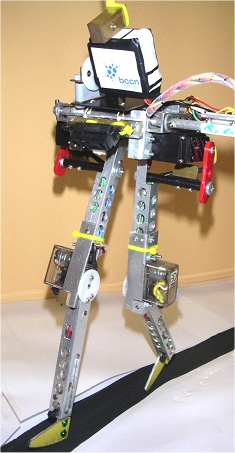Science Fiction
Dictionary
A B C D E F G H I J K L M N O P Q R S T U V W X Y Z
RunBot Learns To Walk At Human Speed

RunBot, a biomechatronic pair of legs that can walk at 3.5 leg-lengths per second, has now achieved human walking speed. RunBot is different from those other biped bots, who walk like your great-grandfather. RunBot's mechanical structure is directly driven by motor-neurons of its neuronal controller, which is analogous to what happens in human and animals' walking.

(RunBot)
Here's the technical scoop on RunBot:
It is 23 cm tall, foot to hip joint axis. Each leg consists of two degrees of freedom: hip and knee joints. Each hip joint is driven by a modified RC servo motor producing a torque up to 5.5 kg.cm while the motor of each knee joint produces a smaller torque (3 kg.cm) but has fast rotating speed with 21 rad/s. The built-in servo control circuits of the motors are disconnected while the built-in potentiometer is used to measure the joint angles. A mechanical stopper is implemented on each knee joint to prevent it from going into hyperextention similar to human kneecaps.Runbot has no actuated ankle joints resulting in very light feet and being efficient for fast walking. Its feet were designed having a circular form 4.5 cm long similar to passive biped robots. Each foot is equipped with a switch sensor to detect ground contact. This mechanical design of Runbot has some special features, e.g. small curved feet and a properly positioned center of mass that allow the robot to perform natural dynamic walking during some stage of its gait cycles.
In addition, the active upper body component is implemented on the top of its hip joints for balance in walking on different terrains, e.g. up and down slopes.
When RunBot encounters a slope, the higher level functions of the robot are used.
Professor Woergoetter, of the University of Gottingen, in Germany, said: "When Runbot first encounters a slope these low level control circuits 'believe' they can continue to walk up the slope without having to change anything.Professor Woergoetter's goal with RunBot is simple: walk like a person, and not like a clunky movie robot. And it really works; check out the video of RunBot shown below."But this is misguided and as a consequence the machine falls backwards. This triggers the other sensors and the highest loop we have built into Runbot - the learning circuitry - and from that experience of falling the machine knows that something needs to be changed."
Via LiveScience; see also the RunBot Fast Dynamic Walking Robot website. Thanks also to Zac for suggesting this story.
(RunBot walks on)
Scroll down for more stories in the same category. (Story submitted 7/12/2007)
Follow this kind of news @Technovelgy.| Email | RSS | Blog It | Stumble | del.icio.us | Digg | Reddit |
Would
you like to contribute a story tip?
It's easy:
Get the URL of the story, and the related sf author, and add
it here.
Comment/Join discussion ( 0 )
Related News Stories - (" Robotics ")
Proof Of Robothood - Not A Person
'Who are you people? - Show 'em.' - James Cameron (1984).
Dancing Robots Taught Dance Moves
'A clockwork figure would be the thing for you...' Jerome K. Jerome, 1893.
Factory Humanoid Robots Built By Humanoid Robots
'...haven't you a section of the factory where only robot labor is employed?' - Isaac Asimov (1940).
Mornine Sales Robot
'Robot-salesmen were everywhere, gesturing...' - Philip K Dick, 1954.
Technovelgy (that's tech-novel-gee!) is devoted to the creative science inventions and ideas of sf authors. Look for the Invention Category that interests you, the Glossary, the Invention Timeline, or see what's New.
Science Fiction
Timeline
1600-1899
1900-1939
1940's 1950's
1960's 1970's
1980's 1990's
2000's 2010's
Current News
Natural Gait With Prosthetic Connected To Nervous System
'The leg was to function, in a way, as a servo-mechanism operated by Larry’s brain...'
Woman Marries Computer, Vonnegut's Dream Comes True
'Men are made of protoplasm... Lasts forever.'
Spidery 'Walk Me' Toyota Autonomous Wheel Chair Like Star Wars
Walk along with the emperor.
Dancing Robots Taught Dance Moves
'A clockwork figure would be the thing for you...'
Proof Of Robothood - Not A Person
'Who are you people? - Show 'em.'
Indonesian Clans Battle
'The observation vehicle was of that peculiar variety used in conveying a large number of people across rough terrain.'
The 'Last Mile' In China Crowded With Delivery Robots
Yes, it's a delivery robot. On wheels.
Tornyol Microdrone Kills Mosquitoes
'The real border was defended by... a swarm of quasi-independent aerostats.'
PLATO Spacecraft, Hunter Of Habitable Planets, Now Ready
'I ... set my automatic astronomical instruments to searching for a habitable planet.'
Factory Humanoid Robots Built By Humanoid Robots
'...haven't you a section of the factory where only robot labor is employed?'
iPhone Air Fulfils Jobs' Promise From 2007 - A Giant Screen!
'... oblongs were all over the floor and surfaces.'
ChatGPT Now Participates in Group Chats
'...the city was their laboratory in human psychology.'
iPhone Pocket All Sold Out!
'A long, strong, slender net...'
Did The Yautja Have These First?
What a marvel of ingenuity the little device was!
Jetson ONE Air Races Begin, Can Air Polo Be Far Behind?
'If you're one of those rarities who haven't attended a rocket-polo "carnage", let me tell you it's a colorful affair.'
Will Space Stations Have Large Interior Spaces Again?
'They filed clumsily into the battleroom, like children in a swimming pool for the first time, clinging to the handholds along the side.'
